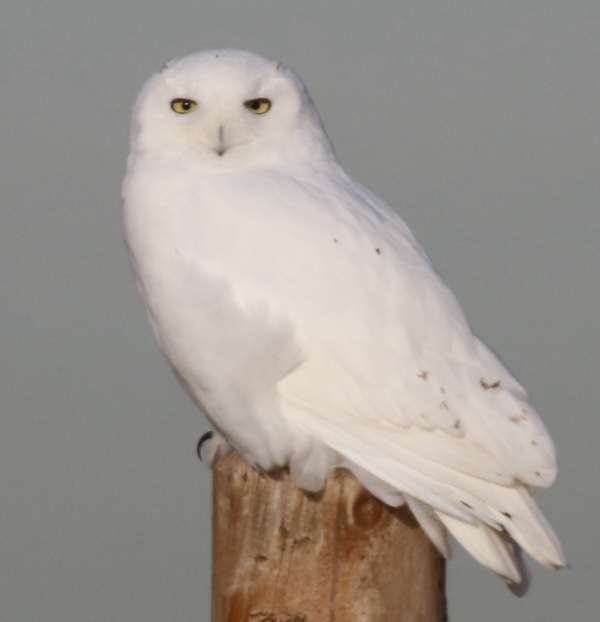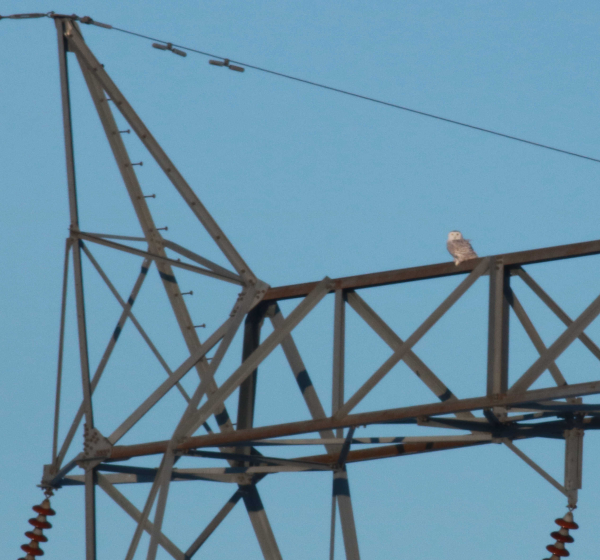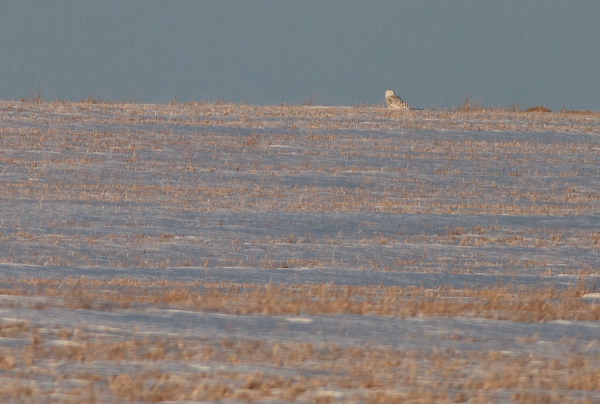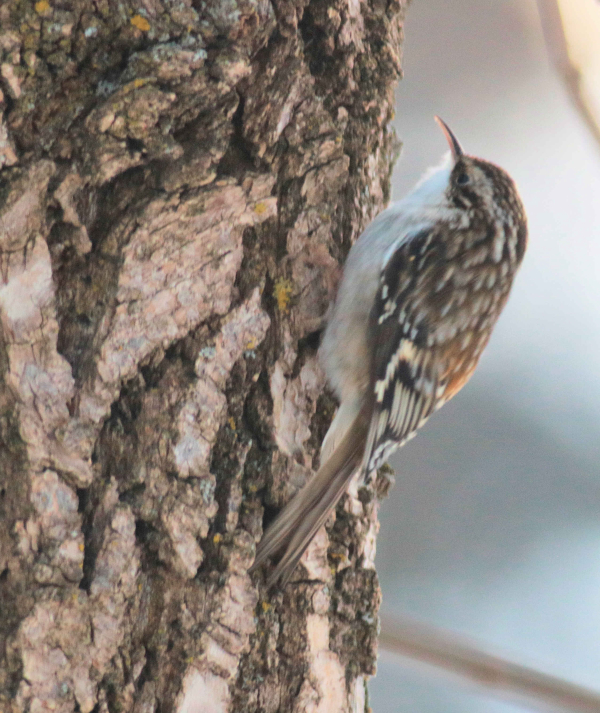
A reminder of the owl in this photo that he took two winters ago, a striking white male Snowy Owl surprised Paul as he expanded his search for the female Snowy.

During a second visit to the area, the female Snowy eventually showed herself for a brief time, perched atop a tall metal powerline tower.

During Paul’s third visit to the Steele Snowy site, the female was quickly obvious as she stood on a slight rise in a snow-covered field, a few hundred feet from where she was sighted two days before. She remained at this location throughout Paul’s observations.

Closer to home, visits on consecutive Sundays by a Brown Creeper provided moments of heart-pounding excitement at close quarters a couple days ago.
|
It’s been an unusually poor winter for Snowy Owl sightings – some years I find as many as 89 different Snowys, but so far this winter, none. So when I learned of repeated sightings of a Snowy Owl in a location about 95 miles northwest of home, I reacted to the bright sunshine the next day by taking a field trip to the wide open plains near Steele, North Dakota. The information I had was two days old, but the adult female Snowy Owl had frequented the area for more than a week, so I had high hopes of seeing her – or perhaps I would find a different one along my extended drive through prime Snowy Owl country.
Even though I scanned diligently along the way, as I always do, the birds I observed along the way only included a few Snow Buntings near home and four hen pheasants a half hour to the west. I had high hopes as I approached my Snowy destination, but I couldn’t see the difference between this location and hundreds of other landscape views I had along the way, but it might be related to the abundance of meadow voles that have kept the female Snowy within a couple square miles for an extended time.
The landscape was snow-covered and consisted of a harvested wheat field broken by a few small wetlands that provided taller plants. To the north, an alfalfa field probably provided even more vole habitat, and it had many large round hay bales that provided elevated perches, as did a few large rock piles. South of the fields a gravel road provided access for me to scan the landscape and skyscape diligently. A line of wooden powerline poles provided more perches along the road, but I actually expected the owl to be perching on the tall metal powerline towers that were spaced about five per mile east to west, but after driving back and forth across a few miles of the owl’s recent territory with no luck, I began expanding my search.
East of the recent Snowy sightings, I drove north two miles to the next gravel road that I could drive west along. I was edgy, watching for any movement and concentrating my attention primarily ahead of me and to the south. More than a mile down the road, my attention was drawn to a fencepost on the corner of a native prairie pasture. I was about a half mile away, so took a closer look with my binoculars and realized that not only was this the first Snowy Owl of the season for me, it was a beautiful white adult male Snowy! I took a couple photos to document the bird from a distance; then pondered my next move.
This obviously was not the female Snowy Owl I was looking for, but it was an even more exciting personal find within two miles of where the female was being reported. While I didn’t want to disturb the “new” owl, I also wanted to check the area for the female. I began to ease forward to see what might transpire – maybe I could get to a location where I could photograph the male without disturbing it, and check the surrounding area for the female, especially the landscape to the south. I took another look at the male, and knowing I would need to pass by the owl in order to take advantage of the light provided by the setting sun, I figured the owl was too close to the road – maybe just a dozen feet – to pass by without the brilliant white owl flushing. So I searched the landscape in all directions, and decided to call my search for the female adequate in that area. As I took a final look at the great white owl, it reminded me of a photograph I took two winters ago of a similar-looking male perched on a post, which I share with you on this page.
I returned to the area where the female Snowy has been hanging out, but not a feather was to be seen as daylight began to dim. The unexpected stunning white male certainly made the trip worthwhile, and I knew I would return in a few days in route to Bismarck. Maybe I would cross paths with the female then, or re-find the male, or even discover another cold weather gem. On my return home, I found a pair of Bald Eagles perched in a large cottonwood tree, about 15 miles east of the Snowy site.
Tuesday (January 7th) was the next sunny day, and after completing work at my office, I took another route to the Steele Snowy Owl area. Again, my latest information was 48 hours old, but indicated the female was still active in the same square mile area, so I hoped get a look at her this time. On the way to Steele I found two Sharp-ailed Grouse, a flying Bald Eagle, and two lone pheasants – a male and a female. I had high hopes of finding the female as I scanned the area along the frontage road, but without luck after passing through the prime area and continuing west a couple more miles, I turned back and gave it another try, only to see a Snowy perched exactly where I expected it to be – atop one of the tall metal powerline towers.
As I approached closer and took a good look with binoculars I verified this was a female Snowy, that was distinguished by brown markings and undoubtedly the girl I was after. I took a few documentary photos from about 150 yards away, and didn’t linger too long. The female apparently flew to this prominent perch during the short time after my first pass through the area. I don’t think she remained there very long either, for when I returned 20 minutes later, I couldn’t relocate her during an extended observation period. I used the 20 minutes to try to relocate the white male Snowy I discovered three days earlier to the north, but I had no luck finding that bird again. Even so, I was happy to find another beautiful Snowy Owl, and I planned to be back Thursday on my way to Bismarck.
So last two days later, on my way to Bismarck I checked back on my Steele owls. It was very windy, so I expected the owls and any other birds would probably be perched in a low profile location, which might make relocating the owls more difficult, but almost immediately I spied the female Snowy Owl standing on the ground in the open field about two hundred yards northwest of the tower perch where I found her 48 hours before. I took a few documentary photos and continued to survey the area as usual, then search for the male to the north, but didn’t see any other birds. The female Snowy remained in the same location when I rechecked her positioned, so I continued on my way to Bis, keeping vigilant for other birds along the way and glad to have had a week of Snowy Owl observations.
The following days were cloudy and even colder with temperature barely slipping above zero, so I limited my birding observations to my feeders, but Sunday I ventured afield, only to find three Sharp-tailed Grouse perched on distant tree branches. But when I returned home, I appreciated a return visitor – or was it a new one?
Brown Creeper!
After more than a month without a new bird in my yard, a week ago Sunday my attention was diverted to the ash tree adjacent to my feeding station by a new bird – a Brown Creeper, one of my favorites. But the sighting only lasted a few moments and it was gone. I figured it was a one sighting wonder, but this Sunday I was surprised to see a Brown Creeper again! It was about the same time of day, 4:35, as the sun was setting. I waited a few long moments to grab my camera for fear of scaring the creeper with my movements, but in moments I was within eight feet of it, photographing through one of my bay windows.
After a short period, the Creeper dropped to the ground, which kind of surprised me, and next it switched to the front ash tree, foraging near the base and working its way up the trunk about five feet, before returning to the closer tree again. That’s where I was able to get my best photos of the little creeper as it actively pried methodically at the recesses of the bark in search of food. As I followed it in the low light, I wished the creeper had come a couple hours earlier when the tree trunk was bathed in pretty afternoon sunlight. I knew the creeper was moving quickly for the 1/100th shutter speed I could muster, but I did get one sharp image of it among the photos I took, which I share with you here. Some of the other images that showed varied amounts of blurred action were kind of fun to review too. I do like Brown Creepers, and I hope this one returns more often while I’m watching the action at my feeding station out of the corner of my eye.
Enjoy your mid-January birding opportunities and unexpected sightings. At this point in winter I must admit: My thoughts turn to wading birds in warm coastal marshes with sunlight reflecting off azure blue water – spoonbills, herons, and ibis come to mind – and maybe some white cranes.
Article and photos by Paul Konrad
Share your bird sightings and photos at editorstbw2@gmail.com